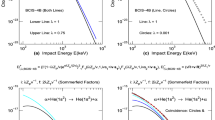Summary
In this paper we propose a theoretical model for high-energy interaction, the basic idea of which is that the high-energy processes are reducible to the low-energy ones, through a peripheral mechanism. The asymptotic properties of this model are studied by means of a linear omogeneous integral equation, whose kernel depends on the low-energy amplitudes. It is shown that many general predictions can be derived which are independent of the detailed form of the low-energy input. The results refer both to high-energy elastic scattering and multiple production. For the inelastic processes we obtain simple general predictions for measurable quantities such as multiplicities, inelasticity and spectra of secondaries. For the elastic scattering we find the characteristic Regge pole behaviour for all scattering amplitudes. The relation between the bound-state problem and diffraction can therefore be understood in a relativistic model which contains in itself both phenomena. We finally discuss the possible corrections of the model by using approximatively the unitarity condition and we find indications of the possible existence of continuous power distribution, or equivalently, of cuts in the complex angular-momentum variable.
Riassunto
In questo lavoro si propone una teoria per lo studio delle interazioni forti di alta. energia. L‘idea di base è che i processi di alta energia sono riconducibili, attraverso un meccanismo periferico, a processi di bassa energia. Le proprietà asintotiche di questo modello vengono studiate per mezzo di un‘equazione integrale agli autovalori, il cui nuoleo è funzione delle ampiezze dei processi di bassa energia. Si mostra come molte predizioni generali possono essere derivate dalla struttura dell‘equazione integrale senza conoscere la soluzione esplicita di questa. I risultati riguardano tanto l‘urto elastico come la produzione multipla di alta energia. Per i processi inelastici noi otteniamo semplici predizioni generali per quel che riguarda la natura, la molteplicità, l‘inelasticità e lo spettro dei secondari. Per l‘urto elastico, noi troviamo il caratteristico comportamento del polo di Regge per le ampiezze. Questo ci permette di capire la relazione tra stati legati e diffrazione in un modello relativistico che contiene entrambi. Si discutono infine alcune correzioni al modello imposto dall‘unitarietà ; queste correzioni suggeriscono l‘esistenza di una continuità di poli di Regge, cioè di tagli nel piano del momento angolare complesso.
Similar content being viewed by others
References
S. Drell:Rev. Mod. Phys.,33, 458 (1961);E. Ferrari andF. Selleri:Suppl. Nuovo Cimento, in press.
I. M. Dremin andD. S. Cherniavski:Zurn. ėkp. Teor. Fiz.,40, 1333 (1961). Cf., also,V. B. Berestetski and I.Ya. Pomeranchuk:Proc. of the 1960 Conference on High-Energy Physics, p. 333;V. N. Gribov: ibid., p. 340.
D. Amati, S. Fubini, A. Stanghellini andM. Tonin:Nuovo Cimenta,22, 569 (1961).
Phys. Lett.,1, 29 (1962).C. Goebel:Proc. of Int. Conf. on Theor. Aspects of Very-High Energy Phenomena (CERN, 1961), p. 353;V. B. Berestetski andI. Ya. Pomeranchuk:Nucl. Phys.,22, 629 (1961).
T. Regge:Nuovo Cimento,14, 951 (1959);18, 947 (1960).
G. F. Chew andF. Low:Phys. Rev.,113, 1640 (1959);C. Goebel:Phys. Rev. Lett.,1, 337 (1958).
S. Drell:Phys. Rev. Lett.,5, 342 (1960);F. Salzman andG. Salzman:Phys. Rev. Lett.,5, 377 (1960).
E. Ferrari andF. Selleri:Phys. Rev. Lett.,7, 387 (1961).
S. Drell andK. Hiida:Phys. Men. Lett.,7, 199 (1961).
S. Frautschi, M. Gell-Mann andF. Zachariasen :Phys. Rev., in press.
C. Ceolin, F. Duimio, S. Fubini andR. Stroffolini:Nuovo Cimento, in press.
D. H. Perkins:Progr. in Elem. Part, and Cosmic Ray Phys.,5, 328 (1960).
G. Cocconi: Paper presented at 1961 Meeting of the Argonne Accelerator Users Group.
L. Bertocchi, S. Pubini andM. Tonin:Nuovo Cimento,25, 626 (1962).
E. Predazzi andT. Regge:Nuovo Cimento,24, 518 (1962).
I. Ya. Pomeranchuk:Zurn. ėksp. Teor. Fiz.,34, 725 (1958);Sov. Phys. JETP,7, 499 (1958).
M. Froissart:Phys. Rev.,123, 1053 (1961).
S. Hasegawa: INSJ, Tokyo, preprint 48 (1962).
Author information
Authors and Affiliations
Rights and permissions
About this article
Cite this article
Amati, D., Stanghellini, A. & Fubini, S. Theory of high-energy scattering and multiple production. Nuovo Cim 26, 896–954 (1962). https://doi.org/10.1007/BF02781901
Received:
Published:
Issue Date:
DOI: https://doi.org/10.1007/BF02781901




